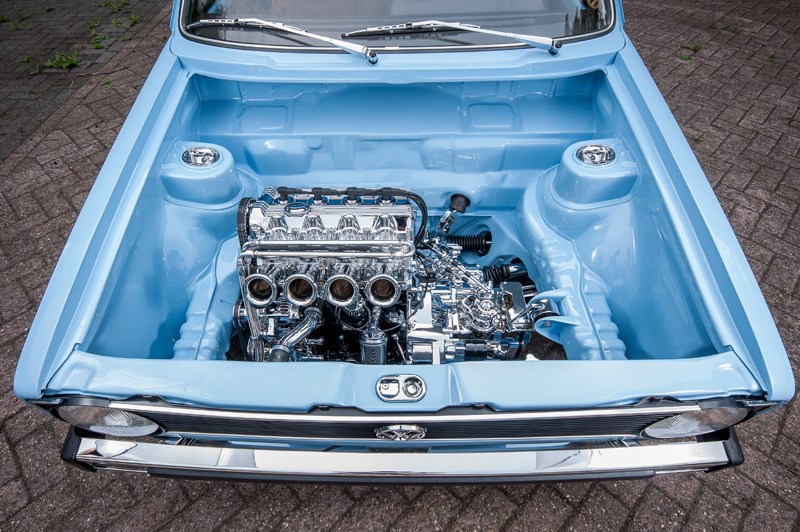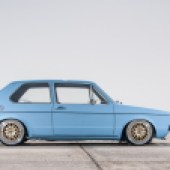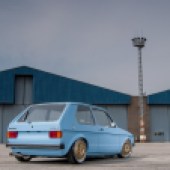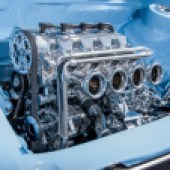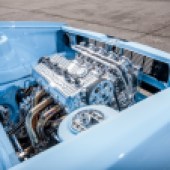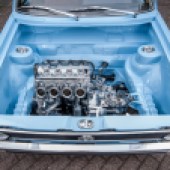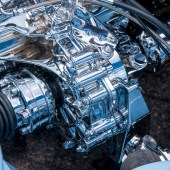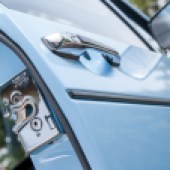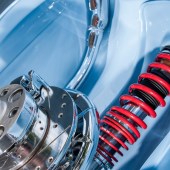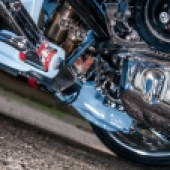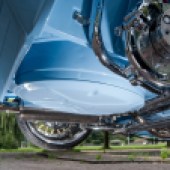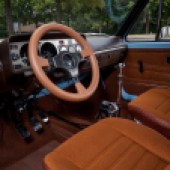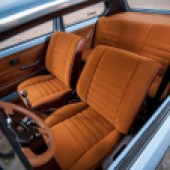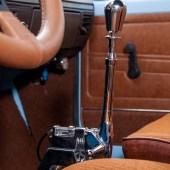We check out Jorg’s stunning Florida blue Mk1 Golf…
I’m curious. Actually, let me rephrase that. I’m intrigued as to what makes a grown man spend hour upon hour in a shed rebuilding, restoring and generally reengineering a car into something so damn perfect that not only is it in better condition than when it originally left the factory (by quite some margin), to the point where they’re too afraid to drive it, but we’re also talking about a level of finish that would stand up to – and in many cases beat – many of the cars on display at the world-renown Pebble Beach Concours event?
It’s safe to say I’ve seen some mind-blowing Mk1s and attempted to get into the heads of many of the madmen that have masterminded these builds. I can honestly say the quality, ingenuity and general wow factor of some of these cars is unrivalled by any other scene, but that doesn’t mean I’m any closer to understanding why they do it. While my idea of washing the car involves a gritty bucket of warm water with a good squeeze of Fairy every six months or so (one of the main reasons I got into VWs was because I loved the fact you didn’t have to care too much about the cars or pamper them to get the best out of them), I was also drawn to the fact that the modified scene was full of people obsessed with taking these bulletproof vehicles to extremes.
I’m not saying I can’t appreciate this type of car, quite the opposite. I think the fact I’m so bad at looking after my own cars makes pouring over a car like Jörg’s stunning creation all the more interesting. I guess not having the time, money or mad skills needed to build something quite so amazing is part of the reason. This probably explains why I’ve got a Golf Rallye in a bodyshop somewhere in West London that I’ve not even laid eyes on for over a year, let alone made any progress with. Now I’ve always got plenty of big ideas when it comes to a build. That’s another reason why something as trick, clever and genuinely rule-bending as this little car really floats my boat even if it’s totally out of my reach.
I remember the exact moment I first spotted the car back in 2004 at the legendary VW Mania show in Belgium. Sadly the event no longer exists but the car very much does. I’d never really seen any Mk1 taken quite to this level back in the day. We literally pulled Jörg and the car straight out of the showfield so we could bag a photoshoot in a nearby disused railway yard. With a bunch of old sleepers as a backdrop, the car just popped under blistering sunshine and the feature went down a storm – especially as we trumped a lot of the big German magazines to a world exclusive. A bit of trivia for the geeks out there: this was the same year and location we shot Big Ron Huijzer’s legendary Mk2 Golf as well (the car which came before his infamous Mk1).
So, back to Jörg, we instantly hit it off and despite his broken English we could tell how passionate he was about the car, as well as being a huge fan of PVW. At the time we remember the German telling us he was pretty happy with the car as it was. Instead, he told us, he had a Mk1 Cabby project he was going to focus on now the Golf was complete. He showed us some taster photos of the Cabrio, which would be built to a similar standard as his Golf, but this time Jörg was planning to use carbon fibre rather than chrome.
So when did he decide to recreate the chrome Golf? “I started the next phase in 2010 when I totally stripped the car ready for a complete rebuild,” he told us. While the colour, Florida blue, may have been used again, it was a complete respray, where no nut or bolt was left unturned. Sure, Jörg could have easily gone for a full colour change but he loved the original shade and it’s kind of how people remember the car. Well, that and the ridiculous level of build. Well, for us it was mind-blowing, but by 2010 Jörg was worried that so many other people had upped their game that he decided he needed to take things to another level again. And boy is that what he’s done.
Once stripped to a bare metal shell, everything – and we mean everything – was removed that didn’t need to be there. Jörg still wanted to keep an element of the original look to the car, though. By retaining the more prominent original recesses and contours (like the obvious ones in the chassis legs under the bonnet) Jörg has managed to retain a certain OEM look, without falling into the fully-custom category. As we’ve said so many times in the past, you can go too far with the smoothing and blending. Jörg’s masterpiece is a lesson in taking things to the absolute limited without stepping over the mark. You still have to look closely or be a hardcore Mk1 buff to spot all the trick touches though.
Not only did Jörg smooth a lot of unwanted holes, even some that were essential were hidden. A few instances where this method was used include the bumpers, front wings and front splitter. For example, there would once have been fixings along the top of the front wings, visible under the bonnet but now there is nothing. What Jörg did was to bolt the wings on from the opposite direction, so in this case the bolt head is underneath the inner lip of the wing. This was threaded through the wing, the end of the bolt grinded off, then welded over, and then smoothed. This same method was used when mounting the front struts (hence no visible fixings). The chromed solid top mounts were actually produced by Jörg himself, along with the ultra-clean engine mounts and, in case you were still scratching your head, the inlet manifold! The real geeks among you, with a super-keen eye may have also spotted the front bonnet catch mount (fixed to the front slam panel) also has had any visible signs of mounting removed, too. Be honest, I bet you didn’t spot it. Pure genius!
I always used to find it mind-blowing to discover how the top concours guys used to hide the fixings of Jubilee clips and ensure any visible flat-head screw heads all lined-up with one another but this type of modding is taking things to a whole new level.
When you look at the amount of smoothing that’s gone on, especially in places that are never going to see the light of day, you really begin to appreciate what a perfectionist Jörg is. Not only has he removed all the sounded deadening from underneath the car he’s then proceeded to smooth the entire floor (the smoothed spare wheel well is a work of art in itself) to a finish which, according to our photographer Oliver Verheij (who himself built one of the top ten Mk1s to ever grace these pages) is better than the paint on the roof of a Maybach. “The floor’s been painted twice with clear varnish and then highly polished!” exclaimed Oliver.
Obviously everything that’s not painted body colour or plastic has been polished and chromed. And we mean everything. The guy has even chromed his fuel tank! So while this is a functioning car in terms of the fact that the engine runs and it can be driven, it’s about as close to a rolling work of art as you’re ever going to get. And while Jörg doesn’t try to hide the fact that the car is the ultimate trailer queen, he was adamant that it needed to remain a car that could be driven, even if it was only so he could cruise up on stage to pick up the many trophies it was no-doubt going to scoop.
We’ve kind of brushed over the other super-rare parts (which would normally be on the top of a regular feature car’s build list), which is testament to the extremes Jörg has gone to with the aforementioned custom mods. Let’s face it, a completely polished 1.6-litre 16S (16v) Oettinger motor (which replaces the conventional two-litre 16v on carbs) with forged Mahle internals that increase capacity to 1.8-litres and a custom inlet manifold (to which a pair of 42mm AT-Power ITBs are bolted ) is never going to get overlooked. It’s just slightly more in your face when compared to the other super-subtle mods.
We just love how minimal things are under the bonnet, but that it still looks like an Mk1 Golf bay, and not just some ultra-smooth jelly mould. It’s awesome how Jörg has obviously put so much time into deciding which parts should stay and the others that can be ditched. He felt the need to erase the visible wing fixings, which are pretty small in their original state but then decided to retain the wipers… on a car that is clearly never going to leave the house, let alone turn a wheel in so much as remotely moist conditions. Other parts that got the elbow include the battery and tray, the heater matrix and all associated plumbing, the brake servo and the wiper motor and mechanism. The only visible cables under the bonnet are the plug leads, throttle cable (which routes from under ITBs across the gearbox and through the firewall), clutch cables and speedo cable. Other than the fuels lines, that’s your lot, unless you get on your knees and look really closely. The power cables are all routed under the engine (wrapped in black protective mesh) and leave the engine via the front engine mount, then route through the front panel and round to the relocated battery.
Those that remember the car first time around will probably notice that the conversional brake servo has now been ditched in favour of an upside down race-style pedalbox. Oh, and the calipers have now been chromed, too. Of course they have! Jörg has also fitted all-new chromed Ultralow H&R coilovers, installed along with modified wishbones and the aforementioned spherical bearing top mounts.
Choosing a wheel to suit such a radical but classic-looking car was never going to be easy but Jörg felt the fully chromed 15” Porsche Teledials needed replacing with something slightly more racy. We reckon he’s found the perfect solution in the E26 Motorsport mags it now sports. The classic BBS have been given a slightly more extreme look thanks to the lairy vital stats (6×17” ET25 with 10mm spacers up front and 6.5×17” ET25 with 25mm spacers out back), which create super-pokey faces encircled with modern 165/35 R17 Nankang rubber. We can’t think of a better setup that works so well with the theme of the car.
Inside, things are ever so slightly more toned down, but we really like it like this. When we last featured the car it was actually still using its original trim, which included a number of authentic rips in the fabric. For this latest makeover any flaws (original or not) weren’t going to meet the grade. The original brown GL dashboard remains but the seats have been modified to lose their headrests and then fully retrimmed in Cognac brown fabric. The period ’80s Raid steering wheel has been retrimmed in matching brown leather, plus the roof lining has been coated in black leather and the only really racy touch to give the game away is the polished motorsport shifter. Under the dash you’ll find the new race car pedalbox with polished reservoirs and the MBE ECU. A single fuel pressure gauge is also hidden away under there so Jörg can keep an eye on it during those long drives to shows.
To those that don’t know it’s an incredibly clean Mk1 Golf with some nice shiny bits bolted on. To those in the know? Well, it’s just about the most radical Mk1 Golf ever built.
The car really is a work of art. It’s as close as you’re going to get to a life-sized model car. The fit and finish demonstrates a whole new level of attention to detail and something we can’t really ever see anybody bettering, which means Jörg has achieved his goal. To go one step further would surely mean going over-the-top, wouldn’t it?!
TECH SPEC: MK1 GOLF
ENGINE: Original Oettinger 1.6-16S (16v) engine which started out with 136PS but now has considerably more thanks to capacity being increased to 1.8-litres, Mahle forged internals, flowed head with home-made inlet manifold, AT-Power 42mm ITBs with MBE 967 management, adjustable cam wheel, race alternator, custom slim-line aluminium radiator with no header tank, custom engine mounts, custom exhaust manifold, Powersprint 63.5mm system with home-made middle box and S-pipe. Completely polished/chromed engine, with all ancillaries chromed, polished or removed!
CHASSIS: BBS E26 wheels in 6×17” ET25 (with 10mm spacers) up front and 6.5×17” ET25 (with 25mm spacers) out back with centres and inners painted BBS gold and outer lips polished, Nankang 165/35 R17 tyres, chromed H&R Ultralow coilovers with modified wishbones, homemade solid top mounts, polybushes throughout, chromed 256mm Scirocco 16v front brakes, chromed calipers, Mk2 Golf 16v rear discs (polished), all suspension and brake components chromed or polished, chromed fuel tank, piping, rear beam, wishbones, brackets, hubs, stub axles, etc
OUTSIDE: Full respray in Florida blue, floor fully smoothed inside and out, semi-smoothed bay, fixings smoothed for front wings, bumpers and splitter, pop-out front quarter lights, chromed door mirrors, handles (with black inserts), filler cap, wiper arms, black side trims (upper and lower)
INSIDE: All hinges, locks and catches chromed, GL front seats with headrests removed, Cognac brown material used for retrim, black leather headlining, motorsport shifter, VDO gauges, ’80s Raid wheel retrimmed in matching brown leather, race car pedalbox, with polished reservoirs, MBE ECU and fuel pressure gauge hidden under dashboard

